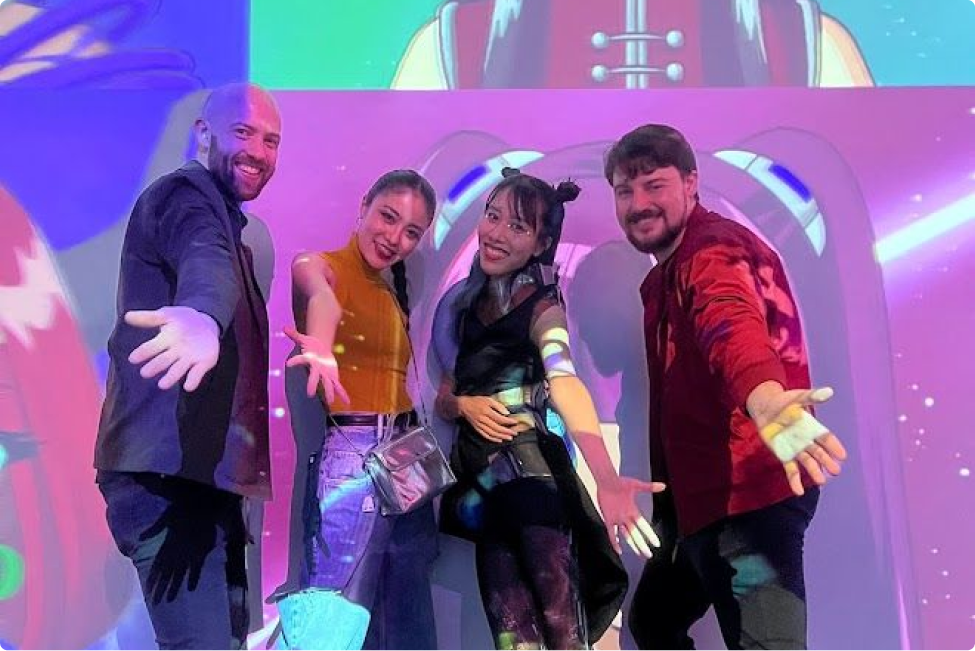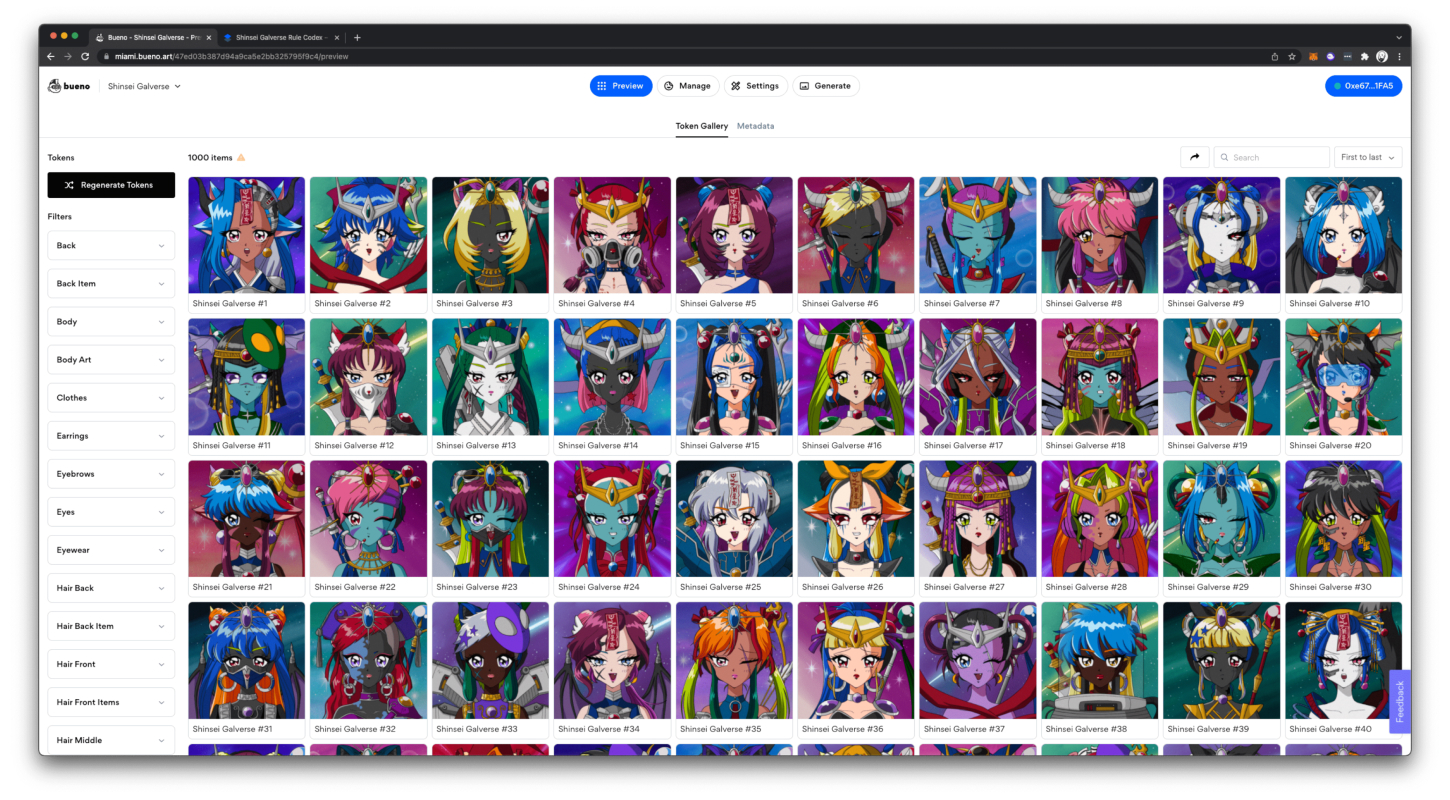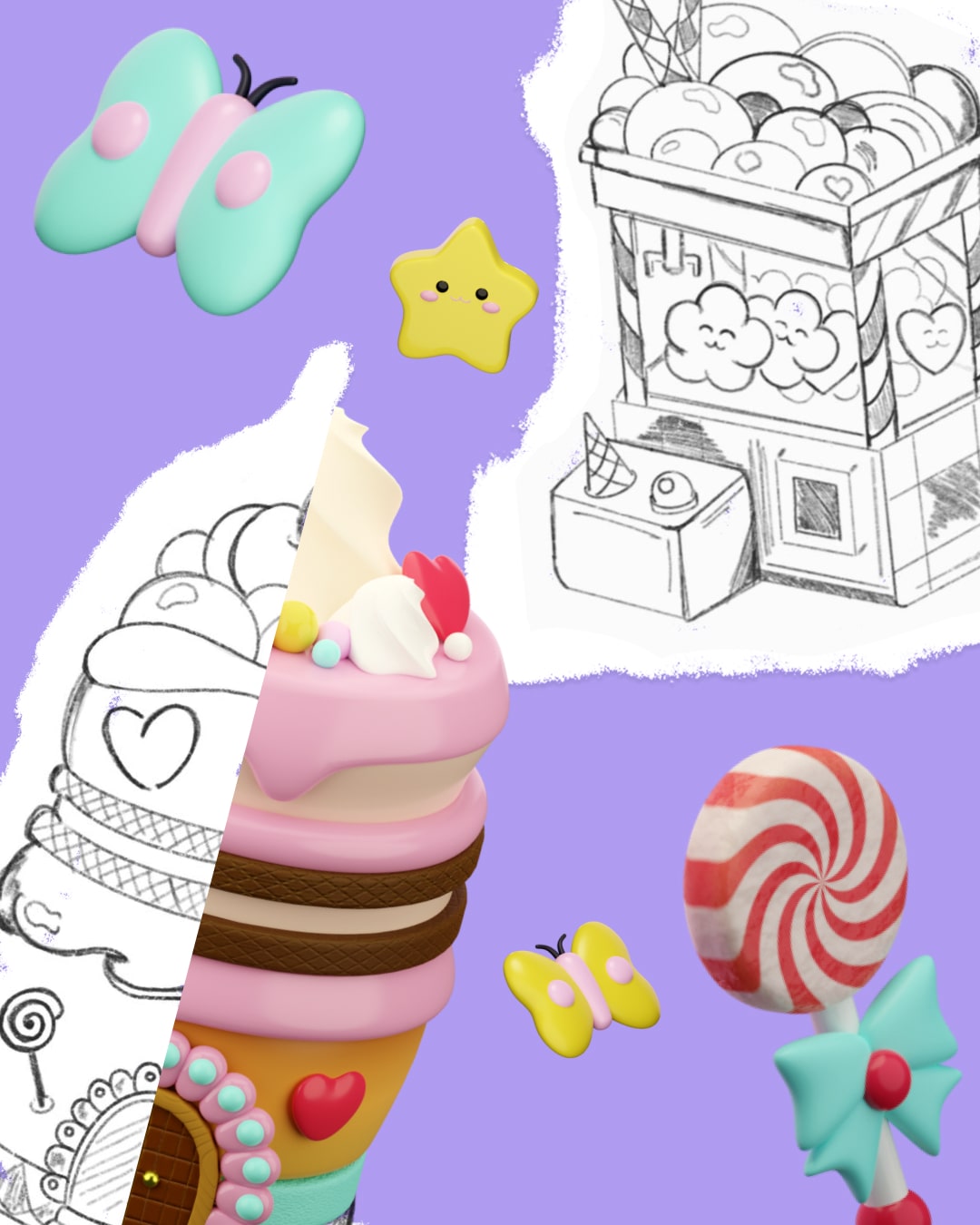A holy planet, the source of goodness and balance in the galaxy, mysteriously explodes into 8,888 shards.
Shinsei Galverse: Creating Japan’s First Breakout Web3 Success with Bueno

Shooting through space and time, each fragment of the planet turns into a Gal, bringing a project of peace to all people and cultures.
Shinsei Galverse reimagines classic anime with badass Gals at the center, creating something both nostalgic and entirely new.
A global team with its creative heart in Tokyo, Galverse was Japan’s first breakout Web3 success, sitting in the #1 position of OpenSea’s NFT rankings for days after its release in April.
The team’s ultimate goal is to turn Galverse into an iconic IP, underpinned by a real anime production dreamed up and created in their native Japan.
Galverse comprises many complex parts: amazing art by Ayaka, custom metadata written by the team in partnership with AI, and specialized smart contracts to launch it into the world.
The team decided early on to use Bueno for all of its art generation and customization. While it’s possible to generate NFT sets using programmatic methods, their small team was looking to move fast and utilize tools wherever possible to make the most of their limited time before launch day.
In February, Bueno was still very much in Beta, and Galverse was a project with nearly 10x complexity compared to other Bueno collections. Not everything was smooth sailing Despite being an extremely complicated and intricate project, Bueno was able to generate an iconic NFT collection.

Meet the superstar Galverse team
Galverse was created by a small team of 4 co-founders - two sets of friends who crossed paths in Web3 - now working as a boutique creative studio.
Ayaka Ohira is Galverse’s artist and animator. She has made a living as an independent animator, creating and directing music videos for some of Japan’s biggest musical acts. Initially self-taught, Ayaka went on to study under legendary animators like Yoji Kuri and Manabu Ohashi.
Emi Kusano is the Creative Director and spokesperson of Shinsei Galverse. Emi is a musician, the lead singer of the retro synth-wave band ‘Satellite Young,’ a published author, a lecturer at the prestigious Tokyo University of Arts, and now regularly appears on primetime TV in Japan to talk about NFTs and Web3.
Devin Mancuso is the Creative Technologist. Devin has worked in senior design roles at Google, Android, YouTube, Dropbox, and YouTube AR/VR. His work has crossed from Web2 into Web3 with a major focus on tools for creativity, immersive technologies, and the future of creative work.
Jack Baldwin (Wailoaloa) is responsible for all the Cs: community, communications, and collaborations. He has a journalism and business development background and is an unrepenting Web3 degen and classic anime tragic.
The dream behind Galverse
Ayaka and Emi met in 2018 when Ayaka made a classic cel-style animated video for Emi’s band, Satellite Young. They became fast friends, sharing a love of fashion, nostalgic Showa-era anime, and - most importantly - both having a ‘Gal’ mindset.
Gals are one of the many fashion tribes of Japan, and while the style has evolved over the years, they are known for having a headstrong and optimistic view of life and their world.
Since they met, Ayaka and Emi have shared their dream of making a classic anime together, inspired by the classic era they love but with a firm focus on badass women.
“Ayaka and I both love Showa-era anime; there are many great stories. But often the main character is a badass guy, and the women are unfeeling, sexy cyborgs or just there to fall in love with the main character,” Emi says.
They made a music video for Emi’s solo song, ‘Glass Ceiling,’ which was a prototype for Galverse. Glass Ceiling reimagined retro dating games by featuring independent women living their own lives. This was big because it once again flipped the gender narrative on its head.
Based on Emi and her friends, the women in the video became prototypes of the Gal characters. The general look (minus pixel-art), style, and outfits ended up featuring in the Galverse project two years later!
Ayaka had already made a name for herself as an independent artist and animator and often received requests to imitate other art styles for her work with musicians. Galverse is her own style through and through - the kind of thing she has been drawing since she was a child and whenever she had creative control of her own projects.
The dream of making an anime was just a dream - until Web3 came along. Devin, a member of crypto culture DAO ‘FWB,’ reached out to Emi after her son’s pixel-art project ‘Zombie Zoo’ had gotten attention in the DAO.
A series of 1/1 artworks by then 8-year-old ‘Zombie Zoo Keeper’ (ZZK), they became a mini-Web3 phenomenon. Devin approached Emi as a collector, inspired by Loot and its derivatives, to maybe turn his next collection into something more experimental and technical.
Emi asked ZZK - and he firmly said no, he had no interest! But Ayaka, Emi, and Devin set off with a new idea to make a generative collection inspired by 80s and 90s animation, with a mission of turning that creative world into a real anime production.
Jack was the last member of the team to join a few months after the original team had been working on concepts and plans.
Devin showed me some of Ayaka’s early artwork, and I was blown away. I knew that anyone who grew up in the late 80s or 90s watching morning cartoons would transport back to that childhood feeling right away, just like I was.
Concept work and planning had kicked off around September 2021. The whole team came together in January 2022 and publicly released the first Galverse artwork into the world soon after.

An overwhelming amount of traits and layers
One of Galverse’s distinguishing features is its sheer amount of traits in the collection: well over 2,000 individual traits across 22 layers, which was orders of magnitude more traits than a typical collection. The majority of NFT collections are somewhere around 200 - 500 traits.
“When Ayaka delivered the first PSD file to load into Bueno, we were blown away,” Devin says, “her art is amazing. But because there were so many layers, and because she illustrated everything before we actually experimented with Bueno, we were in for some surprises putting it together.”
The team anticipated it would take a few days to load the final artwork into Bueno, create the rules that manage the generation of the set, and finally audit the generated artwork. The process turned into weeks of work due, in large part, to the massive number of rules and traits.

Initially there were some complications due to the sheer number of traits for Galverse. For example, the average 10k collection generated with Bueno would have 50 rules but Galverse had 1000 so this was an exciting challenge for a product that was still in beta. Performance was tested as the product was pushed to a level of complexity it hadn’t seen before. But after some late-night discussions the team was able to make updates that helped make the process smoother for the Galverse team.

Intricate, amazing, way overcooked! Before creating any rules or applying rarity curves, the Gals each carried a huge amount of traits.
Beyond that, there are multiple decorations and hair items that Gals have. These were initially divided into three or four layers, but the team flattened them in the metadata into one property. For example, some hats only looked right between the front and back of the hair layers, but a hairpin had to appear in front. In the end, these all show up as ‘Hair Items.’
The result was thousands of complex rules governing the creation of Gal artwork. At first, this process went quite fast. The whole team would look at traits and layers of generated Gals and note the rules that needed to be made. Devin and Jack were eventually working in shifts to create the rules.

“The interesting thing to me was that the rule-making process was just as artistic as it was technical,” says Devin.
A lot of rules were simple - like this hair glitches when it touches this earring trait. But Ayaka and Emi also had strong views about certain outfits or accessories not working with other traits, even if they technically looked okay.
After a few days of rule generation, the system began to experience some issues trying to handle thousands of rulesets.
“When Bueno was in beta, there wasn’t a lot of documentation as to how it applied rules and in which order,” Jack says, “so it was already a game of trial and error figuring out how that worked when things started getting really complex."
The team eventually confirmed some rules were not applying, but with more collaboration and hard work from the Bueno engineers, they were able to fix most of these issues stemming from the vast number of rules and traits.
At this point, the team worked in shifts around the world, almost 24 hours a day, 7 days a week, creating rules and fixing minor errors on the artwork token by token.

Artists first
Backups became more important as the art audit went on, and Bueno engineers also added experimental features like custom token pinning to help with the process. Since the feature was not just beta but totally experimental, that feature helped the audit and introduced some more bugs into the fold.
“At that point, we’d reached the end of making more rules. With that much complexity, a new rule could introduce more generation errors. So we decide to generate the final set of tokens and review each of the 8,888 Gals one by one.”

By using custom tokens, they could make minor adjustments to the Gals that required them without regenerating the whole set of artwork. Eventually, there were well over a thousand custom tokens that might have one minor art error which was only fixable by hand.
Once again, the sheer weight of numbers broke the experimental feature. Custom tokens started to disappear mysteriously or would be unpinned and show up or duplicate themselves elsewhere in the system.
The creation of a Gal
As you add layers and your art becomes more complex, you multiply the complexity of the rules you need to make the final product. It’s exponential.
For example - each hairstyle in Galverse is divided into three layers - front, middle, and back. Some front hairstyles only mix with certain back hairstyles but can mix with any middle hairstyles - and so on. In addition, all hairstyles need to match in color.
If their eyebrows have color, Ayaka was very set that the eyebrow color should match the hair color. But some eyebrows match any hairstyle or color, and the rules must also consider that.
The engineers again investigated, recovered the lost tokens, and implemented a fix. This extended the audit process again, as the team continued working before realizing the missing token problem. They had re-checked and fixed some tokens with errors and recovering the lost tokens resulted in more duplicates.
Despite the hurdles faced by launching a very complex NFT project, the end result of the hard work and deep and committed collaboration with the Bueno team was a final set that looked fantastic.
“Ultimately,” Jack says, “every bit of effort was worth it, even if the process was a long one. Galverse was created with the feeling of ‘artists first.’ One day Ayaka asked the team to make a change to the rules, and she explained that when she was going to see the collection on OpenSea for the first time, she wanted to feel 100% that it was her artwork. It’s such an obvious but powerful statement!”

Tips for other teams
The Galverse team has no plans to launch a second collection anytime soon, but it’s essential for projects to share lessons learned and wisdom picked up along the way.
“Crypto Coven has been great about sharing the technical and creative process of creating their project. We read everything they released before we launched and took a lot of inspiration for Galverse,” Devin says, “so we feel it’s important to do the same.”
Even with an art generation tool like Bueno, there are important considerations when kicking off a project.
Firstly, the whole team should experiment with Bueno before the art is finished and get a feeling for the process of using it and generating NFT artwork. Planning the art layout can simplify the generation and audit process a lot.
Secondly, understand that more complexity in layers and traits equals exponential increases in the number of rules and time it takes to finalize a collection. Bueno can handle the backend load this generates now, but more time spent auditing is less time spent on other tasks.
“More complexity is not a bad thing at all,” Devin says. “On the surface, the Galverse art looks simple due to its style. But the diversity of the collection and the fine details of layers interacting result from that complexity. It just takes more time to do it right.”
Finally, be as flexible as possible. Set firm deadlines to work internally, but don’t announce a launch date until you are 100% confident you will reach it.
“Launching Galverse was way more work than we first thought,” Jack says. “We decided early to keep the sale date under wraps - partly because there were so many unknowns in the process. You have to deal with many things outside your control, so when you face delays or things break, it’s much easier to handle if you haven’t set a public launch date.”
The Galverse team decided to use their own in-house engineers and smart contract to launch the collection but used Bueno to export all the artwork and metadata. Months later, Bueno launched their own no-code smart contract deployer.
Ultimately, art is just one part of an NFT project. A massive amount of work went into smart contracts, metadata, marketing, community building, and collaborations in the lead-up to launching Galverse.
But it’s undeniable that art is the first thing people see when they see a collection - and setting a high-quality bar is critical.
Launching Galverse and beyond
Galverse eventually launched in mid-April 2022. The collection sold out in around five hours, reached the number one spot on OpenSea for daily volume, and stayed there for days after release.

Beyond established artists like Murakami, it was the first large project from Japan to be a breakout success in the global NFT space. As of July, it has done over 5,000 ETH in volume of secondary sales.
Around 24 hours after selling out, over 1,000 Gal community members joined the reveal party on the project’s Discord. Minutes before the art reveal, Emi played the theme song she had created for Galverse in an amazing moment for the community.
The team has been laser-focused on progressing Ayaka and Emi’s dream of making a Galverse anime. The whole team met in person, for the first time, in May when Devin and Jack traveled to Japan to kick off meeting production studios and anime legends.

They’ve also traveled to NFT NYC, where they held the project’s first IRL event, and keep in touch with the community via daily discord chats, weekly team notes, and monthly Town Halls on Twitter Spaces.
Ayaka is still hard at work creating art for Galverse full time, with the first chapters of the Galverse manga released to Gal Holders as well.
“We actually log into Bueno now and then,” Jack says. “Ayaka sometimes uses it to make drafts of custom Gals quickly, which we make for special people in the community and IRL, and the interface is a handy way for me to write custom metadata too.”
“Even since we used the tool, it’s matured a lot. There are features I would have loved to have at the time - better rarity tools; the user experience is smoother too.”
“I think we are almost over the trauma from that last sprint too.”






